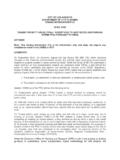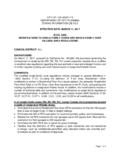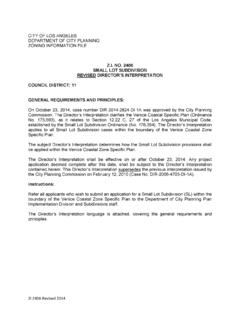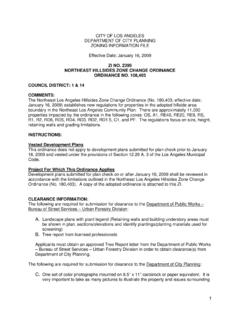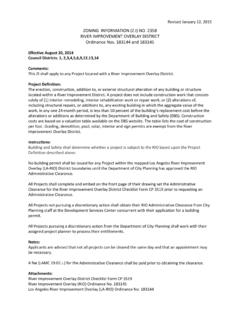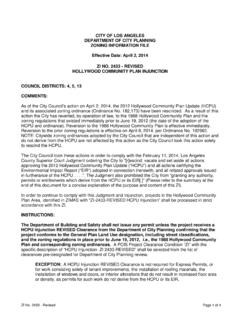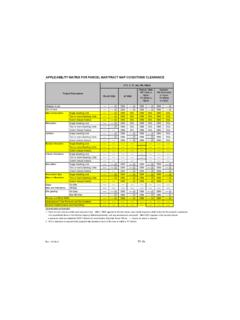Transcription of ZONING INFORMATION (Z.I.) NO. 2427 FREEWAY …
1 ZONING INFORMATION ( ) NO. 2427 FREEWAY adjacent advisory notice FOR sensitive USES Effective: November 8, 2012 Council District: Citywide, within 1,000 feet of freeways Instructions: All applicants filing a discretionary application for which the City Planning Commission is the initial decision-maker or the decision-maker on appeal, shall receive a copy of the attached advisory notice . The advisory notice applies to the following types of discretionary applications: Discretionary Permit LAMC Section Conditional Use Permits granted by the CPC U Density Bonus Public, Quasi-Public Open Space Land Use Categories Zone Change General Plan Amendment Major Project Review/CUP Tentative Tract Map Preliminary Parcel Map Please review the Frequently Asked Questions attachment and refer any other pre-filing questions regarding the notice or its applicability to the Development Services Center (213) 482-7077 or Inquiries regarding the applicability of the advisory notice to a specific project or case may be directed to the Project Planner assigned to the application.
2 FREEWAY adjacent advisory notice FOR sensitive USES FREQUENTLY ASKED QUESTIONS 1. Why am I receiving a copy of the FREEWAY adjacent advisory notice ? In recent years, the City Planning Commission (CPC) has taken an increased interest in projects classified as sensitive receptor sites, particularly schools and residential uses, in close proximity to freeways . In order to inform applicants of the CPC s concerns on the matter and provide guidance for addressing this issue from the early inception of a project, the FREEWAY adjacent advisory notice is being distributed to all applicants for new projects and expansions of existing development involving sensitive uses within 1,000 feet of freeways . 2. Why was 1,000 feet chosen as the boundary for the advisory notice ? freeways are a major stationary source of air pollution and their impact on the air we breathe and public health in cities has been and continues to be a subject of public health research.
3 Scientific literature previously focused on impacts to immediately surrounding communities within 500 feet of freeways ; however, recent studies have established strong links to negative health outcomes affecting sensitive populations as far out as 1,000 feet from freeways , in some instances up to one mile. The Commission felt that 1,000 feet would be a conservative distance that would include potential properties that could house populations considered to be more at-risk of the negative effects of air pollution caused by FREEWAY proximity. 3. Are the recommendations in the advisory notice mandatory? The advisory notice is informational in nature and does not impose any additional land use or ZONING regulations. It is intended to inform applicants of the significance of this issue for the City Planning Commission.
4 Several recommended approaches are highlighted to assist in navigating through this complex issue; however, applicants need not adhere to any one particular method for addressing air quality impacts on a particular project. Project design features or conditions may be tailored to individual projects as deemed appropriate. 4. Is this a prohibition or a moratorium? The FREEWAY adjacent advisory notice is not a prohibition or moratorium on new development near freeways . It is advisory only and serves as an early notification to applicants of discretionary projects who may not otherwise be aware of the potential impacts on future building occupants of siting a building near a FREEWAY . The notice provides background on the issue and guidance that will assist the City Planning Commission in making required findings for discretionary approvals after considering the unique circumstances of each individual case.
5 advisory notice REGARDING sensitive USES NEAR freeways TO: APPLICANTS FOR NEW PROJECTS AND EXPANSIONS OF EXISTING DEVELOPMENTS INVOLVING sensitive USES WITHIN 1,000 FEET OF freeways FROM: THE CITY PLANNING COMMISSION EFFECTIVE DATE: NOVEMBER 8, 2012 CITY PLANNING COMMISSION S STATEMENT OF CONCERN: The purpose of this notice is to alert applicants to the City Planning Commission s recent concerns relative to the placement of sensitive uses near freeways . In recent years, the City Planning Commission (CPC) has taken an increased interest in projects classified as sensitive receptor sites, particularly schools and residential uses, in close proximity to freeways . APPLICABILITY AND INTENT OF THIS notice : This notice serves to advise applicants for discretionary land use requests under the authority of the City Planning Commission of the Commission s concerns.
6 Project design alternatives have been identified below. If integrated into the project design, these measures may help to reduce or address impacts and public health risks, and therefore, should be considered. BACKGROUND: Review of recent air pollution studies shows a strong link between the chronic exposure of populations to vehicle exhaust and particulate matter from roads and freeways and elevated risk of adverse health impacts, particularly in sensitive populations such as young children and older adults. Areas located within 500 feet of a freeway1 are known to experience the greatest concentrations of fine and ultrafine particulate matter (PM), a pollutant implicated in asthma and other health conditions. In 2003, the California Legislature enacted SB 352, which precludes the siting of public schools within 500 feet of a FREEWAY , unless it can be shown that any significant health risk can be mitigated.
7 On January 26, 2009 the City Planning Department presented a report to the City Planning Commission in response an earlier Commission request for Department staff to outline recommendations addressing the issue of public health and FREEWAY proximity. In response to a subsequent request on November 11, 2011, the Planning Department submitted a report in January 2012 outlining potential mitigation measures for housing projects in proximity to freeways . On July 12, 2012 the CPC directed staff to prepare an advisory notice notifying applicants of the Commission s interest and careful consideration of public health implications in their review of FREEWAY - adjacent projects. DEFINITION OF sensitive USES: South Coast AQMD s Guidance Document for Addressing Air Quality Issues in General Plans and Local Planning, defines a sensitive receptor as a person in the population who is particularly susceptible to health effects due to exposure to an air contaminant.
8 1 FREEWAY , as defined in the Caltrans Highway Design Manual Chapter 60, pg. 60-2: (May 7, 2012) FREEWAY --A divided arterial highway with full control of access and with grade separations at intersections. The following are land uses ( sensitive sites) where sensitive receptors are typically located: residences schools, playgrounds and childcare centers long-term health care facilities rehabilitation centers adult day care/convalescent centers hospitals retirement homes EXISTING ADOPTED POLICIES: The City s General Plan already contains adopted policies addressing health-based risks and outcomes. Below are a few that are directly related to the placement of sensitive uses near freeways . Air Quality Element Policy : Revise the City s General Plan/Community Plans to ensure that new or related sensitive receptors are located to minimize significant health risks posed by air pollution sources.
9 Housing Element Policy : Whenever possible, assure adequate health-based buffer zones between new residential and emitting industries. Housing Element Policy : Establish standards that enhance health outcomes. A Finding of consistency with the existing policies in the City s adopted General Plan will be weighed in the Commission s consideration of each project, as set forth in LAMC Section (Land Use Legislative Actions): Procedure for Applications. (Amended by Ord. No. 173,754, Eff. 3/5/01.) Once a complete application is received, as determined by the Director, the Commission shall hold a public hearing or direct a Hearing Officer to hold the hearing. If a Hearing Officer holds the public hearing, he or she shall make a recommendation for action on the application. That recommendation shall then be heard by the Planning Commission, which may hold a public hearing and shall make a report and recommendation regarding the relation of the proposed land use ordinance to the General Plan and whether adoption of the proposed land use ordinance will be in conformity with public necessity, convenience, general welfare and good ZONING practice.
10 STANDARD CONDITIONS AND DESIGN ALTERNATIVES TO CONSIDER: Currently, there is no requirement to provide mitigation measures to address diminished ambient air quality in projects that are developed by-right - that is, without discretionary approval. However, with projects that require discretionary approval, the City has an opportunity to impose conditions to lessen the effects of air pollution exposure. Incorporating the following standard conditions can further enable the Commission to evaluate the merits of a project in order to make the required Findings. Though impact analysis of the air environment on new sensitive receptors in proximity to transportation facilities is not required by CEQA, in the interest of providing INFORMATION to the public, and creating healthy communities, the following measures should be taken under advisement.
